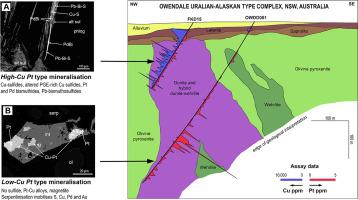当前位置:
X-MOL 学术
›
Ore Geol. Rev.
›
论文详情
Our official English website, www.x-mol.net, welcomes your
feedback! (Note: you will need to create a separate account there.)
Platinum mineralisation in the Owendale Uralian-Alaskan-type complex, New South Wales, Australia: the effects of serpentinization on Cu-PGE-Ni sulphides
Ore Geology Reviews ( IF 3.2 ) Pub Date : 2021-03-01 , DOI: 10.1016/j.oregeorev.2020.103928 Reid R. Keays , David A. Holwell , Hazel M. Prichard
Ore Geology Reviews ( IF 3.2 ) Pub Date : 2021-03-01 , DOI: 10.1016/j.oregeorev.2020.103928 Reid R. Keays , David A. Holwell , Hazel M. Prichard

|
Abstract Significant, albeit highly erractic, PGE mineralization is hosted in the ultramafic rocks of the Owendale Complex, a Uralian-Alaskan type intrusion in the Fifield region of central New South Wales, Australia. Three types of PGE mineralization have been identified in drill core samples of these rocks. The first to be recognized was PGE mineralization associated with “P-units” which are narrow (a few millimetre to 2 metre wide) lenses of pegmatoidal clinopyroxenites within olivine clinopyroxenites; the best intersection of this type of mineralization averaged 13.19 g/t Pt and 0.90 g/t Pd over 1.57 metres, has very low S contents and contains a primary magmatic PGM assemblage. Two types of PGE mineralization occur within dunites and wehrlites, a low-Cu Pt type and a high-Cu Pt type of mineralization. The low-Cu Pt type of mineralization consists mainly of disseminated Cu-Pt-(Fe) alloys that lie along the mesh lines of partially serpentinized olivine; this type of mineralization can have grades of up to 25 g/t Pt but very low amounts of Cu, S, Au and Pd. The high-Cu Pt type of mineralization consists of disseminated, partially oxidised PGE-rich Cu sulphides with Pd-bearing PGM; this type of mineralization has up to 25 g/t Pt and elevated levels of Cu, S, Se, Au and Pd. The Pt:Ir:Rh ratios of the low-Cu Pt and the high-Cu Pt types of mineralization are virtually identical attesting to a common source, but with variable removal of the more mobile Pd, Au, Cu and Se. Some of the high-Cu Pt type sulphides are associated with an unusual Cr-Al-Ti-Mg-rich magnetite that occurs in veins and pods that are up to 15 cm thick. Phlogopite is a common accessory mineral in the dunites and wehrlites, occurring as disseminated grains and pods of mica that are up to 4 cm wide, and as selvedges along the Cr-Al-Ti-Mg-rich magnetite veins. Owendale represents a staging chamber in which olivine cumulates, followed by clinopyroxenite cumulates, were formed and later infiltrated from above by immiscible Fe-rich and Cu-sulphide melts. It is suggested that the phlogopite was produced by K2O-rich fluids released from the monzonites and diorites that intruded the ultramafics and which also drove serpentinisation. Serpentinisation altered the dunite/wehrlites with small amounts of sulphides to remove all the S and most of the Cu, Au, and Pd to leave only Cu-Pt-(Ni-Fe) alloys, forming the low-Cu Pt type of mineralization, whereas the magmatic sulphides in dunites/wehrlites with larger amounts of sulphides were only partially altered, forming the high-CuPt type of mineralization. The Pt alloys produced during serpentinization of the PGE-rich Cu sulphides at Owendale are predominantly Cu-rich, unlike the Pt-Fe alloys found in the placer deposits associated with most Uralian-Alaskan complexes. However, the Owendale Complex was lateritized, as were the Uralian-Alaskan Complexes in the Urals. It is possible that during lateritization, the Cu-Pt-Fe alloys were converted into Pt-Fe alloys similar to those found in the Pt placers.
中文翻译:

澳大利亚新南威尔士州 Owendale Uralian-Alaskan 型复合体中的铂矿化:蛇纹石化对 Cu-PGE-Ni 硫化物的影响
摘要 尽管高度不稳定,但 PGE 矿化位于澳大利亚新南威尔士州中部 Fifield 地区的乌拉尔-阿拉斯加型侵入体 Owendale Complex 的超基性岩中。在这些岩石的钻芯样本中已经确定了三种类型的 PGE 矿化。第一个被识别的是与“P-单元”相关的 PGE 矿化,它是橄榄石单斜辉石岩内的伟晶状斜辉石岩的窄透镜(几毫米到 2 米宽);这种类型矿化的最佳交叉点在 1.57 米范围内平均为 13.19 g/t Pt 和 0.90 g/t Pd,具有非常低的 S 含量并包含原生岩浆 PGM 组合。两种类型的 PGE 矿化发生在纯英岩和卫理岩中,即低 Cu Pt 型和高 Cu Pt 型矿化。低铜 Pt 类型的矿化主要由沿部分蛇纹石化橄榄石的网格线分布的浸染 Cu-Pt-(Fe) 合金组成;此类矿化的品位最高可达 25 克/吨 Pt,但 Cu、S、Au 和 Pd 的含量非常低。高铜 Pt 类型的矿化由浸染的、部分氧化的富含 PGE 的 Cu 硫化物和含 Pd 的 PGM 组成;这种类型的矿化具有高达 25 克/吨的 Pt 和更高水平的 Cu、S、Se、Au 和 Pd。低 Cu Pt 和高 Cu Pt 类型矿化的 Pt:Ir:Rh 比率实际上相同,证明了共同来源,但移动性更强的 Pd、Au、Cu 和 Se 的去除率不同。一些高铜 Pt 型硫化物与一种不寻常的富含 Cr-Al-Ti-Mg 的磁铁矿有关,这种磁铁矿出现在厚度达 15 厘米的矿脉和豆荚中。金云母是纯云母和辉长岩中常见的副矿物,以最大 4 厘米宽的云母粒和豆荚的形式出现,并作为沿富含 Cr-Al-Ti-Mg 的磁铁矿脉的边沿出现。Owendale 代表了一个分期室,其中橄榄石堆积物,随后是斜斜辉石堆积物,形成并随后被不混溶的富铁和硫化铜熔体从上方渗透。这表明金云母是由二长岩和闪长岩释放的富含 K2O 的流体产生的,这些流体侵入超镁铁质并推动蛇纹石化。蛇纹石化用少量硫化物改变了纯晶/卫理石,去除了所有的 S 和大部分的 Cu、Au 和 Pd,只留下 Cu-Pt-(Ni-Fe) 合金,形成低铜 Pt 类型的矿化,而含大量硫化物的纯英岩/伟尔岩中的岩浆硫化物仅部分改变,形成高铜铂矿化类型。Owendale 富含 PGE 的 Cu 硫化物蛇纹石化过程中生产的 Pt 合金主要是富含 Cu 的,这与大多数乌拉尔-阿拉斯加复合体相关的砂矿床中发现的 Pt-Fe 合金不同。然而,欧文代尔建筑群被红土化,乌拉尔的乌拉尔-阿拉斯加建筑群也是如此。有可能在红土化过程中,Cu-Pt-Fe 合金转化为与 Pt 砂矿中发现的合金相似的 Pt-Fe 合金。与在与大多数乌拉尔-阿拉斯加复合体相关的砂矿沉积物中发现的 Pt-Fe 合金不同。然而,欧文代尔建筑群被红土化,乌拉尔的乌拉尔-阿拉斯加建筑群也是如此。有可能在红土化过程中,Cu-Pt-Fe 合金转化为与 Pt 砂矿中发现的合金相似的 Pt-Fe 合金。与在与大多数乌拉尔-阿拉斯加复合体相关的砂矿沉积物中发现的 Pt-Fe 合金不同。然而,欧文代尔建筑群被红土化,乌拉尔的乌拉尔-阿拉斯加建筑群也是如此。有可能在红土化过程中,Cu-Pt-Fe 合金转化为与 Pt 砂矿中发现的合金相似的 Pt-Fe 合金。
更新日期:2021-03-01
中文翻译:

澳大利亚新南威尔士州 Owendale Uralian-Alaskan 型复合体中的铂矿化:蛇纹石化对 Cu-PGE-Ni 硫化物的影响
摘要 尽管高度不稳定,但 PGE 矿化位于澳大利亚新南威尔士州中部 Fifield 地区的乌拉尔-阿拉斯加型侵入体 Owendale Complex 的超基性岩中。在这些岩石的钻芯样本中已经确定了三种类型的 PGE 矿化。第一个被识别的是与“P-单元”相关的 PGE 矿化,它是橄榄石单斜辉石岩内的伟晶状斜辉石岩的窄透镜(几毫米到 2 米宽);这种类型矿化的最佳交叉点在 1.57 米范围内平均为 13.19 g/t Pt 和 0.90 g/t Pd,具有非常低的 S 含量并包含原生岩浆 PGM 组合。两种类型的 PGE 矿化发生在纯英岩和卫理岩中,即低 Cu Pt 型和高 Cu Pt 型矿化。低铜 Pt 类型的矿化主要由沿部分蛇纹石化橄榄石的网格线分布的浸染 Cu-Pt-(Fe) 合金组成;此类矿化的品位最高可达 25 克/吨 Pt,但 Cu、S、Au 和 Pd 的含量非常低。高铜 Pt 类型的矿化由浸染的、部分氧化的富含 PGE 的 Cu 硫化物和含 Pd 的 PGM 组成;这种类型的矿化具有高达 25 克/吨的 Pt 和更高水平的 Cu、S、Se、Au 和 Pd。低 Cu Pt 和高 Cu Pt 类型矿化的 Pt:Ir:Rh 比率实际上相同,证明了共同来源,但移动性更强的 Pd、Au、Cu 和 Se 的去除率不同。一些高铜 Pt 型硫化物与一种不寻常的富含 Cr-Al-Ti-Mg 的磁铁矿有关,这种磁铁矿出现在厚度达 15 厘米的矿脉和豆荚中。金云母是纯云母和辉长岩中常见的副矿物,以最大 4 厘米宽的云母粒和豆荚的形式出现,并作为沿富含 Cr-Al-Ti-Mg 的磁铁矿脉的边沿出现。Owendale 代表了一个分期室,其中橄榄石堆积物,随后是斜斜辉石堆积物,形成并随后被不混溶的富铁和硫化铜熔体从上方渗透。这表明金云母是由二长岩和闪长岩释放的富含 K2O 的流体产生的,这些流体侵入超镁铁质并推动蛇纹石化。蛇纹石化用少量硫化物改变了纯晶/卫理石,去除了所有的 S 和大部分的 Cu、Au 和 Pd,只留下 Cu-Pt-(Ni-Fe) 合金,形成低铜 Pt 类型的矿化,而含大量硫化物的纯英岩/伟尔岩中的岩浆硫化物仅部分改变,形成高铜铂矿化类型。Owendale 富含 PGE 的 Cu 硫化物蛇纹石化过程中生产的 Pt 合金主要是富含 Cu 的,这与大多数乌拉尔-阿拉斯加复合体相关的砂矿床中发现的 Pt-Fe 合金不同。然而,欧文代尔建筑群被红土化,乌拉尔的乌拉尔-阿拉斯加建筑群也是如此。有可能在红土化过程中,Cu-Pt-Fe 合金转化为与 Pt 砂矿中发现的合金相似的 Pt-Fe 合金。与在与大多数乌拉尔-阿拉斯加复合体相关的砂矿沉积物中发现的 Pt-Fe 合金不同。然而,欧文代尔建筑群被红土化,乌拉尔的乌拉尔-阿拉斯加建筑群也是如此。有可能在红土化过程中,Cu-Pt-Fe 合金转化为与 Pt 砂矿中发现的合金相似的 Pt-Fe 合金。与在与大多数乌拉尔-阿拉斯加复合体相关的砂矿沉积物中发现的 Pt-Fe 合金不同。然而,欧文代尔建筑群被红土化,乌拉尔的乌拉尔-阿拉斯加建筑群也是如此。有可能在红土化过程中,Cu-Pt-Fe 合金转化为与 Pt 砂矿中发现的合金相似的 Pt-Fe 合金。











































 京公网安备 11010802027423号
京公网安备 11010802027423号